url?sa=t&source=web&cd=3&ved=0CC0QFjAC&url=http://www.teachingenglish.org.uk/sites/teacheng/files/B369-Young-Learners-Activity-Book_v10
url?sa=t&source=web&cd=3&ved=0CC0QFjAC&url=http://www.teachingenglish.org.uk/sites/teacheng/files/B369-Young-Learners-Activity-Book_v10
url?sa=t&source=web&cd=3&ved=0CC0QFjAC&url=http://www.teachingenglish.org.uk/sites/teacheng/files/B369-Young-Learners-Activity-Book_v10
Create successful ePaper yourself
Turn your PDF publications into a flip-book with our unique Google optimized e-Paper software.
TeachingEnglish <strong>Young</strong> <strong>Learners</strong> <strong>Activity</strong> <strong>Book</strong><br />
Activities<br />
Alternatives<br />
• Songs can also be used to practise day-to-day vocabulary and language structures.<br />
For example, this is the way (I brush my teeth) repeats the present simple tense with a<br />
number of daily routines. Likewise, Ten Little Aeroplanes presents counting up to ten and<br />
back again. These songs, with activities and animations, can be found on the British Council<br />
website learnenglishkids.britishcouncil.<strong>org</strong>/en/songs/ This site also has great songs<br />
to practise stress and rhythm: Chocolate Cake is one of our favourites.<br />
• Songs can be exploited in lots of different ways. Here is an idea from Ornella Granatiero (Italy)<br />
called Go on Singing. In this activity, a song from the children’s course book is used, but you<br />
could use any song. The materials are the same as for the activity on the previous page:<br />
1. Play or sing the song two or three times while the children listen in silence, follow the words<br />
in their books or look at the flashcards.<br />
2. Play or sing the song again two or three times, this time with the children singing and<br />
miming actions.<br />
3. Once the children can sing most of the song, play or sing it again, but stop after a few<br />
lines and ask one of the children or a group of children to continue the song. After one<br />
or two lines, start playing it again. Repeat this, asking different children to continue until the<br />
end of the song.<br />
No resources?<br />
If you do not have equipment to play songs, you can sing them yourself. If you do not have access<br />
to the internet to download song words, you can make up simple songs yourself. The important<br />
thing is that they are memorable for the children with lots of repetition. You could ask the children<br />
to clap or beat the rhythm or to mime actions. Do not worry if you are not a good singer, you can<br />
chant instead.<br />
© British Council 2012<br />
11





